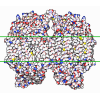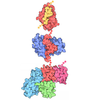+ Open data
Open data
- Basic information
Basic information
| Entry | Database: PDB / ID: 9eij | ||||||||||||||||||||||||
|---|---|---|---|---|---|---|---|---|---|---|---|---|---|---|---|---|---|---|---|---|---|---|---|---|---|
| Title | Import stalled PINK1 TOM complex, extended TOM20 helix class | ||||||||||||||||||||||||
 Components Components |
| ||||||||||||||||||||||||
 Keywords Keywords | TRANSLOCASE / PINK1 / TOM complex / VDAC | ||||||||||||||||||||||||
| Function / homology |  Function and homology information Function and homology informationpositive regulation of synaptic transmission, dopaminergic / positive regulation of free ubiquitin chain polymerization / tRNA import into mitochondrion / TOM complex / positive regulation of cristae formation / voltage-gated monoatomic anion channel activity / mitochondrial transmembrane transport / mitochondrial outer membrane permeabilization / regulation of protein targeting to mitochondrion / Mitochondrial calcium ion transport ...positive regulation of synaptic transmission, dopaminergic / positive regulation of free ubiquitin chain polymerization / tRNA import into mitochondrion / TOM complex / positive regulation of cristae formation / voltage-gated monoatomic anion channel activity / mitochondrial transmembrane transport / mitochondrial outer membrane permeabilization / regulation of protein targeting to mitochondrion / Mitochondrial calcium ion transport / mitochondrion to lysosome vesicle-mediated transport / maintenance of protein location in mitochondrion / mitochondrion targeting sequence binding / establishment of protein localization to mitochondrion / protein kinase B binding / mitochondrial outer membrane translocase complex / cellular response to hydrogen sulfide / Lewy body / phospholipid scramblase activity / regulation of autophagy of mitochondrion / ceramide binding / regulation of synaptic vesicle transport / TORC2 signaling / negative regulation of hypoxia-induced intrinsic apoptotic signaling pathway / protein insertion into mitochondrial outer membrane / mitochondria-associated endoplasmic reticulum membrane contact site / positive regulation of mitochondrial electron transport, NADH to ubiquinone / regulation of oxidative phosphorylation / regulation of hydrogen peroxide metabolic process / migrasome / negative regulation of hydrogen peroxide-induced neuron intrinsic apoptotic signaling pathway / C3HC4-type RING finger domain binding / regulation of cellular response to oxidative stress / protein-transporting ATPase activity / dopamine secretion / voltage-gated monoatomic ion channel activity / negative regulation of autophagosome assembly / positive regulation of dopamine secretion / binding of sperm to zona pellucida / autophagy of mitochondrion / phosphatidylcholine binding / oxysterol binding / positive regulation of type 2 mitophagy / Mitochondrial protein import / cellular response to toxic substance / negative regulation of oxidative stress-induced neuron intrinsic apoptotic signaling pathway / regulation of mitochondrion organization / monoatomic anion transport / negative regulation of JNK cascade / positive regulation of protein targeting to mitochondrion / regulation of reactive oxygen species metabolic process / positive regulation of ubiquitin-protein transferase activity / peptidase activator activity / negative regulation of intrinsic apoptotic signaling pathway in response to hydrogen peroxide / protein targeting to mitochondrion / phospholipid translocation / cholesterol binding / astrocyte projection / positive regulation of mitochondrial fission / negative regulation of macroautophagy / porin activity / negative regulation of mitophagy / pore complex / FOXO-mediated transcription of cell death genes / negative regulation of intrinsic apoptotic signaling pathway / protein import into mitochondrial matrix / positive regulation of release of cytochrome c from mitochondria / positive regulation of ATP biosynthetic process / hemopoiesis / negative regulation of reactive oxygen species metabolic process / mitochondrial nucleoid / positive regulation of macroautophagy / regulation of protein ubiquitination / protein transmembrane transporter activity / regulation of protein-containing complex assembly / negative regulation of mitochondrial fission / mitophagy / monoatomic ion transport / regulation of proteasomal protein catabolic process / sperm midpiece / acrosomal vesicle / positive regulation of translation / response to ischemia / positive regulation of protein ubiquitination / PINK1-PRKN Mediated Mitophagy / cell periphery / regulation of mitochondrial membrane potential / respiratory electron transport chain / mitochondrion organization / macroautophagy / regulation of protein stability / mitochondrial intermembrane space / mitochondrial membrane / kinase binding / kinase activity / unfolded protein binding / growth cone / cell body / response to oxidative stress / cellular response to oxidative stress Similarity search - Function | ||||||||||||||||||||||||
| Biological species |  Homo sapiens (human) Homo sapiens (human) | ||||||||||||||||||||||||
| Method | ELECTRON MICROSCOPY / single particle reconstruction / cryo EM / Resolution: 3.3 Å | ||||||||||||||||||||||||
 Authors Authors | Kirk, N.S. / Glukhova, A. / Callegari, S. / Komander, D. | ||||||||||||||||||||||||
| Funding support |  Australia, 2items Australia, 2items
| ||||||||||||||||||||||||
 Citation Citation |  Journal: Science / Year: 2025 Journal: Science / Year: 2025Title: Structure of human PINK1 at a mitochondrial TOM-VDAC array. Authors: Sylvie Callegari / Nicholas S Kirk / Zhong Yan Gan / Toby Dite / Simon A Cobbold / Andrew Leis / Laura F Dagley / Alisa Glukhova / David Komander /  Abstract: Mutations in the ubiquitin kinase PINK1 cause early-onset Parkinson's disease, but how PINK1 is stabilized at depolarized mitochondrial translocase complexes has remained poorly understood. We ...Mutations in the ubiquitin kinase PINK1 cause early-onset Parkinson's disease, but how PINK1 is stabilized at depolarized mitochondrial translocase complexes has remained poorly understood. We determined a 3.1-angstrom resolution cryo-electron microscopy structure of dimeric human PINK1 stabilized at an endogenous array of mitochondrial translocase of the outer membrane (TOM) and voltage-dependent anion channel (VDAC) complexes. Symmetric arrangement of two TOM core complexes around a central VDAC2 dimer is facilitated by TOM5 and TOM20, both of which also bind PINK1 kinase C-lobes. PINK1 enters mitochondria through the proximal TOM40 barrel of the TOM core complex, guided by TOM7 and TOM22. Our structure explains how human PINK1 is stabilized at the TOM complex and regulated by oxidation, uncovers a previously unknown TOM-VDAC assembly, and reveals how a physiological substrate traverses TOM40 during translocation. | ||||||||||||||||||||||||
| History |
|
- Structure visualization
Structure visualization
| Structure viewer | Molecule:  Molmil Molmil Jmol/JSmol Jmol/JSmol |
|---|
- Downloads & links
Downloads & links
- Download
Download
| PDBx/mmCIF format |  9eij.cif.gz 9eij.cif.gz | 417.9 KB | Display |  PDBx/mmCIF format PDBx/mmCIF format |
|---|---|---|---|---|
| PDB format |  pdb9eij.ent.gz pdb9eij.ent.gz | 335.6 KB | Display |  PDB format PDB format |
| PDBx/mmJSON format |  9eij.json.gz 9eij.json.gz | Tree view |  PDBx/mmJSON format PDBx/mmJSON format | |
| Others |  Other downloads Other downloads |
-Validation report
| Summary document |  9eij_validation.pdf.gz 9eij_validation.pdf.gz | 1.7 MB | Display |  wwPDB validaton report wwPDB validaton report |
|---|---|---|---|---|
| Full document |  9eij_full_validation.pdf.gz 9eij_full_validation.pdf.gz | 1.7 MB | Display | |
| Data in XML |  9eij_validation.xml.gz 9eij_validation.xml.gz | 76 KB | Display | |
| Data in CIF |  9eij_validation.cif.gz 9eij_validation.cif.gz | 112.7 KB | Display | |
| Arichive directory |  https://data.pdbj.org/pub/pdb/validation_reports/ei/9eij https://data.pdbj.org/pub/pdb/validation_reports/ei/9eij ftp://data.pdbj.org/pub/pdb/validation_reports/ei/9eij ftp://data.pdbj.org/pub/pdb/validation_reports/ei/9eij | HTTPS FTP |
-Related structure data
| Related structure data | 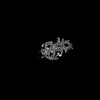 48085MC 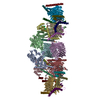 9eihC 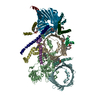 9eiiC M: map data used to model this data C: citing same article ( |
|---|---|
| Similar structure data | Similarity search - Function & homology  F&H Search F&H Search |
- Links
Links
- Assembly
Assembly
| Deposited unit | 
|
|---|---|
| 1 |
|
- Components
Components
-Mitochondrial import receptor subunit ... , 6 types, 12 molecules DIJKLZNXPVRT
| #1: Protein | Mass: 16319.862 Da / Num. of mol.: 1 / Source method: isolated from a natural source / Source: (natural)  Homo sapiens (human) / Cell line: Expi293 / References: UniProt: Q15388 Homo sapiens (human) / Cell line: Expi293 / References: UniProt: Q15388 | ||||||||
|---|---|---|---|---|---|---|---|---|---|
| #3: Protein | Mass: 37926.926 Da / Num. of mol.: 2 / Source method: isolated from a natural source / Source: (natural)  Homo sapiens (human) / Cell line: Expi293 / References: UniProt: O96008 Homo sapiens (human) / Cell line: Expi293 / References: UniProt: O96008#4: Protein | Mass: 6045.318 Da / Num. of mol.: 3 / Source method: isolated from a natural source / Source: (natural)  Homo sapiens (human) / Cell line: Expi293 / References: UniProt: Q8N4H5 Homo sapiens (human) / Cell line: Expi293 / References: UniProt: Q8N4H5#5: Protein | Mass: 6256.473 Da / Num. of mol.: 2 / Source method: isolated from a natural source / Source: (natural)  Homo sapiens (human) / Cell line: Expi293 / References: UniProt: Q9P0U1 Homo sapiens (human) / Cell line: Expi293 / References: UniProt: Q9P0U1#6: Protein | Mass: 8007.988 Da / Num. of mol.: 2 / Source method: isolated from a natural source / Source: (natural)  Homo sapiens (human) / Cell line: Expi293 / References: UniProt: Q96B49 Homo sapiens (human) / Cell line: Expi293 / References: UniProt: Q96B49#7: Protein | Mass: 15532.528 Da / Num. of mol.: 2 / Source method: isolated from a natural source / Source: (natural)  Homo sapiens (human) / Cell line: Expi293 / References: UniProt: Q9NS69 Homo sapiens (human) / Cell line: Expi293 / References: UniProt: Q9NS69 |
-Protein , 2 types, 3 molecules EFB
| #2: Protein | Mass: 31600.445 Da / Num. of mol.: 2 / Source method: isolated from a natural source / Source: (natural)  Homo sapiens (human) / Cell line: Expi293 / References: UniProt: P45880 Homo sapiens (human) / Cell line: Expi293 / References: UniProt: P45880#8: Protein | | Mass: 65561.562 Da / Num. of mol.: 1 Source method: isolated from a genetically manipulated source Source: (gene. exp.)  Homo sapiens (human) / Gene: PINK1 / Cell line (production host): Expi293 / Production host: Homo sapiens (human) / Gene: PINK1 / Cell line (production host): Expi293 / Production host:  Homo sapiens (human) Homo sapiens (human)References: UniProt: Q9BXM7, non-specific serine/threonine protein kinase |
|---|
-Non-polymers , 1 types, 9 molecules 
| #9: Chemical | ChemComp-PC1 / |
|---|
-Details
| Has ligand of interest | N |
|---|---|
| Has protein modification | Y |
-Experimental details
-Experiment
| Experiment | Method: ELECTRON MICROSCOPY |
|---|---|
| EM experiment | Aggregation state: PARTICLE / 3D reconstruction method: single particle reconstruction |
- Sample preparation
Sample preparation
| Component | Name: Complex of VDAC, TOM core and PINK1 / Type: COMPLEX / Entity ID: #8, #1-#7 / Source: RECOMBINANT |
|---|---|
| Molecular weight | Value: 0.75 MDa / Experimental value: NO |
| Source (natural) | Organism:  Homo sapiens (human) Homo sapiens (human) |
| Source (recombinant) | Organism:  Homo sapiens (human) / Strain: EXPI293 Homo sapiens (human) / Strain: EXPI293 |
| Buffer solution | pH: 7.4 |
| Specimen | Conc.: 4.3 mg/ml / Embedding applied: NO / Shadowing applied: NO / Staining applied: NO / Vitrification applied: YES |
| Vitrification | Instrument: FEI VITROBOT MARK IV / Cryogen name: ETHANE / Humidity: 90 % / Chamber temperature: 277 K / Details: Blot force 10 for 2 s. |
- Electron microscopy imaging
Electron microscopy imaging
| Experimental equipment |  Model: Titan Krios / Image courtesy: FEI Company |
|---|---|
| Microscopy | Model: TFS KRIOS |
| Electron gun | Electron source:  FIELD EMISSION GUN / Accelerating voltage: 300 kV / Illumination mode: FLOOD BEAM FIELD EMISSION GUN / Accelerating voltage: 300 kV / Illumination mode: FLOOD BEAM |
| Electron lens | Mode: BRIGHT FIELD / Nominal magnification: 105000 X / Nominal defocus max: 2000 nm / Nominal defocus min: 500 nm / Cs: 2.7 mm / C2 aperture diameter: 50 µm |
| Specimen holder | Cryogen: NITROGEN / Specimen holder model: FEI TITAN KRIOS AUTOGRID HOLDER |
| Image recording | Average exposure time: 3.34 sec. / Electron dose: 52.4 e/Å2 / Film or detector model: GATAN K3 BIOQUANTUM (6k x 4k) / Num. of grids imaged: 2 / Num. of real images: 16992 |
- Processing
Processing
| EM software |
| ||||||||||||||||||||||||||||||||||||||||||||||||
|---|---|---|---|---|---|---|---|---|---|---|---|---|---|---|---|---|---|---|---|---|---|---|---|---|---|---|---|---|---|---|---|---|---|---|---|---|---|---|---|---|---|---|---|---|---|---|---|---|---|
| CTF correction | Details: Patch CTF / Type: PHASE FLIPPING AND AMPLITUDE CORRECTION | ||||||||||||||||||||||||||||||||||||||||||||||||
| Particle selection | Num. of particles selected: 5700000 / Details: Picked using low resolution templates | ||||||||||||||||||||||||||||||||||||||||||||||||
| 3D reconstruction | Resolution: 3.3 Å / Resolution method: FSC 0.143 CUT-OFF / Num. of particles: 165000 / Symmetry type: POINT | ||||||||||||||||||||||||||||||||||||||||||||||||
| Atomic model building |
| ||||||||||||||||||||||||||||||||||||||||||||||||
| Atomic model building |
| ||||||||||||||||||||||||||||||||||||||||||||||||
| Refinement | Highest resolution: 3.3 Å Stereochemistry target values: REAL-SPACE (WEIGHTED MAP SUM AT ATOM CENTERS) | ||||||||||||||||||||||||||||||||||||||||||||||||
| Refine LS restraints |
|
 Movie
Movie Controller
Controller





 PDBj
PDBj
